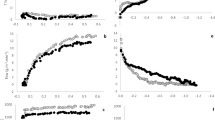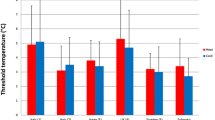Abstract
We evaluated human physiological responses and the performance of manual tasks during exposure to severe cold (–25°C) at night (0300–0500 hours) and in the afternoon (1500–1700 hours). Thirteen male students wearing standard cold protective clothing occupied a severely cold room (–25°C) for 20 min, and were then transferred to a cool room (10°C) for 20 min. This pattern of exposure was repeated three times, for a total time of exposure to extreme cold of 60 min. The experiments were started either at 1500 hours or 0300 hours and measurements of rectal temperature, skin temperature, blood pressure, performance in a counting task, hand tremor, and subjective responses were made in each condition. At the end of the experiment at night the mean decrease in rectal temperature [0.68 (SEM 0.04)°C] was significantly greater than that at the end of the experiment in the afternoon [0.55 (SEM 0.08)°C, P<0.01]. After the second cold exposure at night the mean increase in diastolic blood pressure [90 (SEM 2.0) mmHg] was significantly greater than that at the end of the second cold exposure in the afternoon [82 (SEM 2.8) mmHg, P<0.01]. At the end of the second cold exposure at night, mean finger skin temperature [11.8 (SEM 0.8)°C] was significantly higher than that at the comparable time in the afternoon [9.0 (SEM 0.7)°C, P<0.01]. Similarly for the toe, mean skin temperature at the start of the second cold exposure at night [25.6 (SEM 1.5)°C] was significantly higher than in the afternoon [20.1 (SEM 0.8)°C, P<0.01]. The increased skin temperatures in the periphery resulted in increased heat loss. Since peripheral skin temperatures were highest at night, the subjects noted diminished sensations of thermal cold and pain at that time. Manual dexterity at the end of the first cold exposure at night [mean 83.7 (SEM 3.6) times·min–1] had decreased significantly more than at the end of the first cold exposure in the afternoon [mean 89.4 (SEM 3.5) times·min–1, P<0.01]. These findings of a lowered rectal temperature and diminished manual dexterity suggest that there is an increased risk of both hypothermia and accidents for those who work at night.
Similar content being viewed by others
Author information
Authors and Affiliations
Additional information
Electronic Publication
Rights and permissions
About this article
Cite this article
Ozaki, H., Nagai, Y. & Tochihara, Y. Physiological responses and manual performance in humans following repeated exposure to severe cold at night. Eur J Appl Physiol 84, 343–349 (2001). https://doi.org/10.1007/s004210000379
Accepted:
Published:
Issue Date:
DOI: https://doi.org/10.1007/s004210000379




